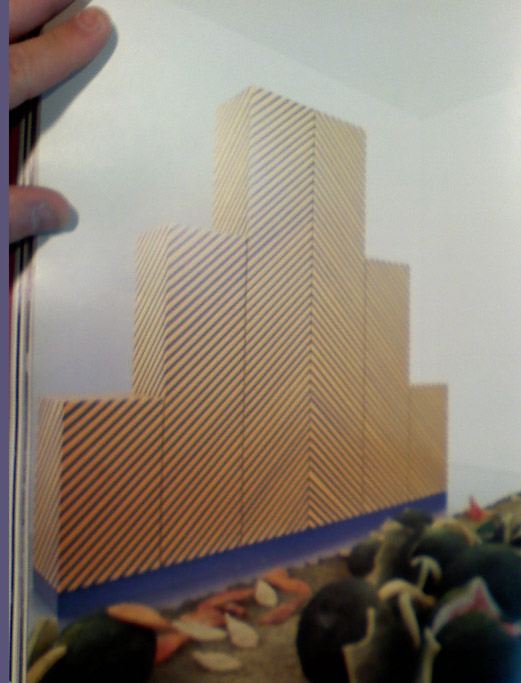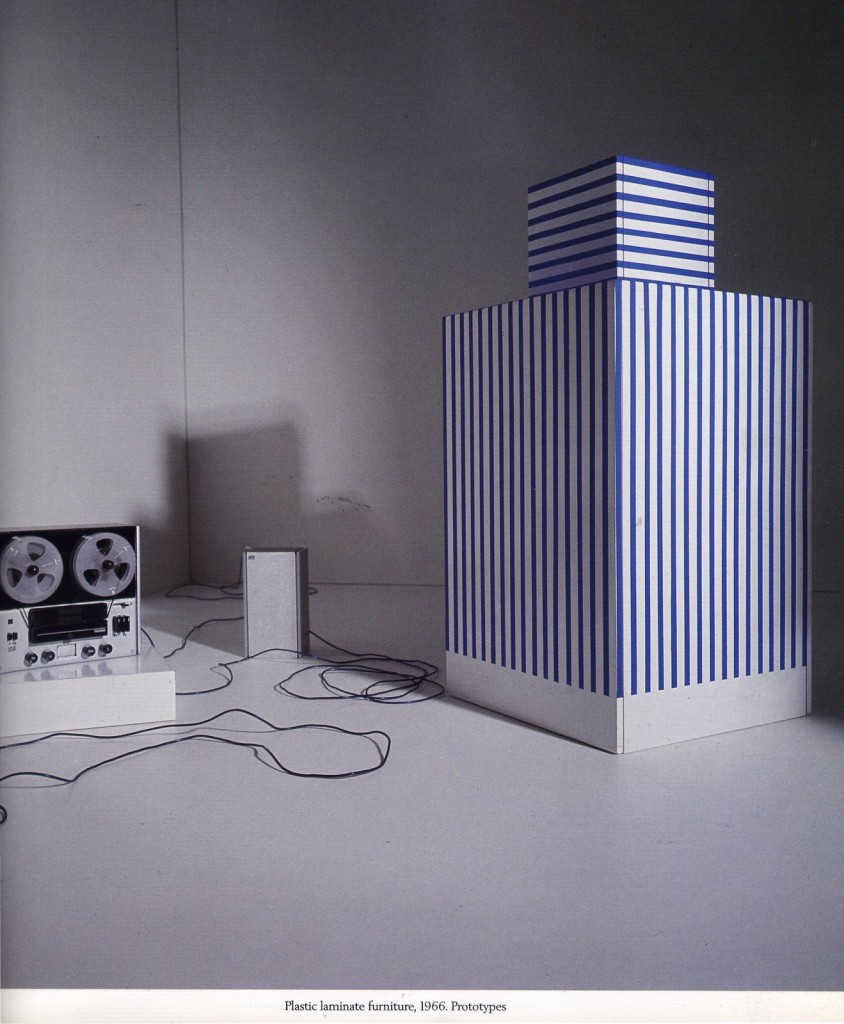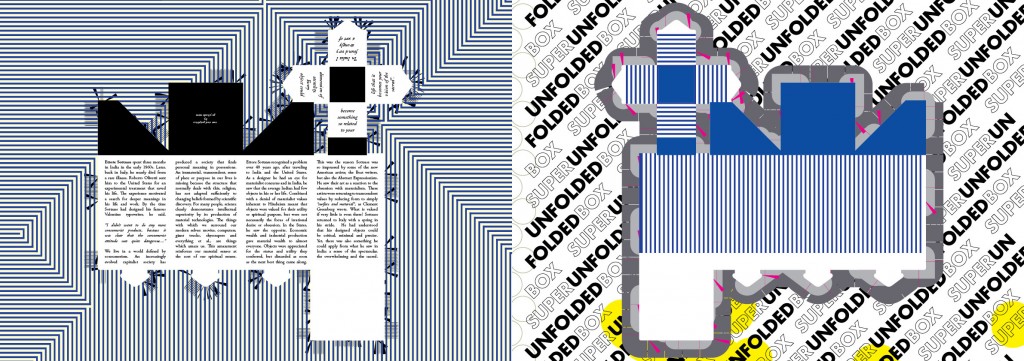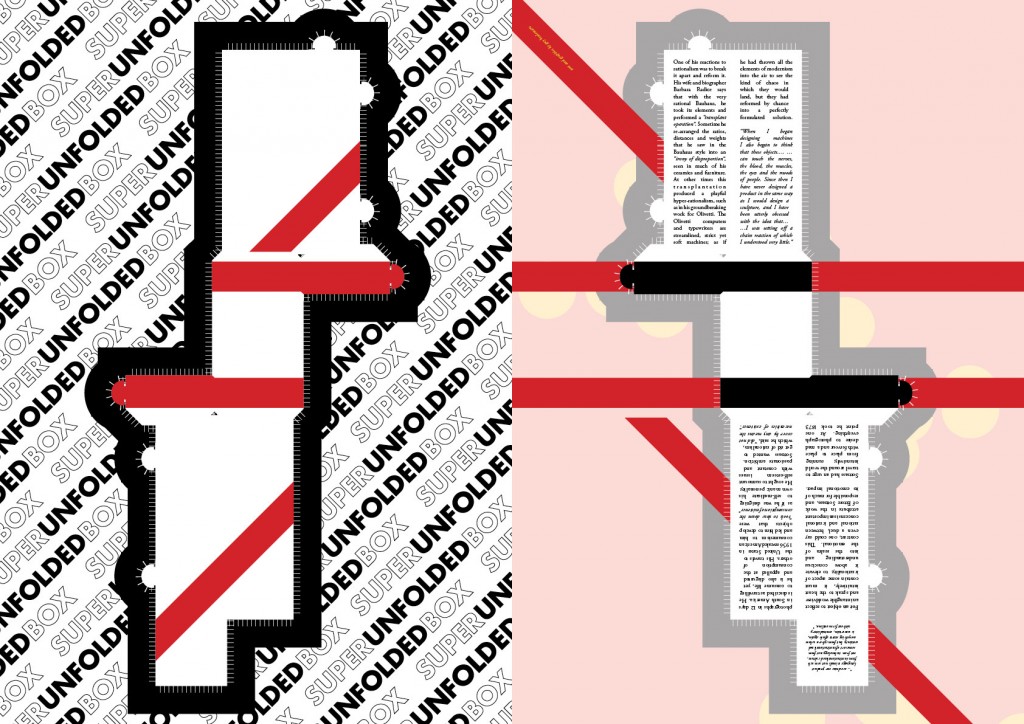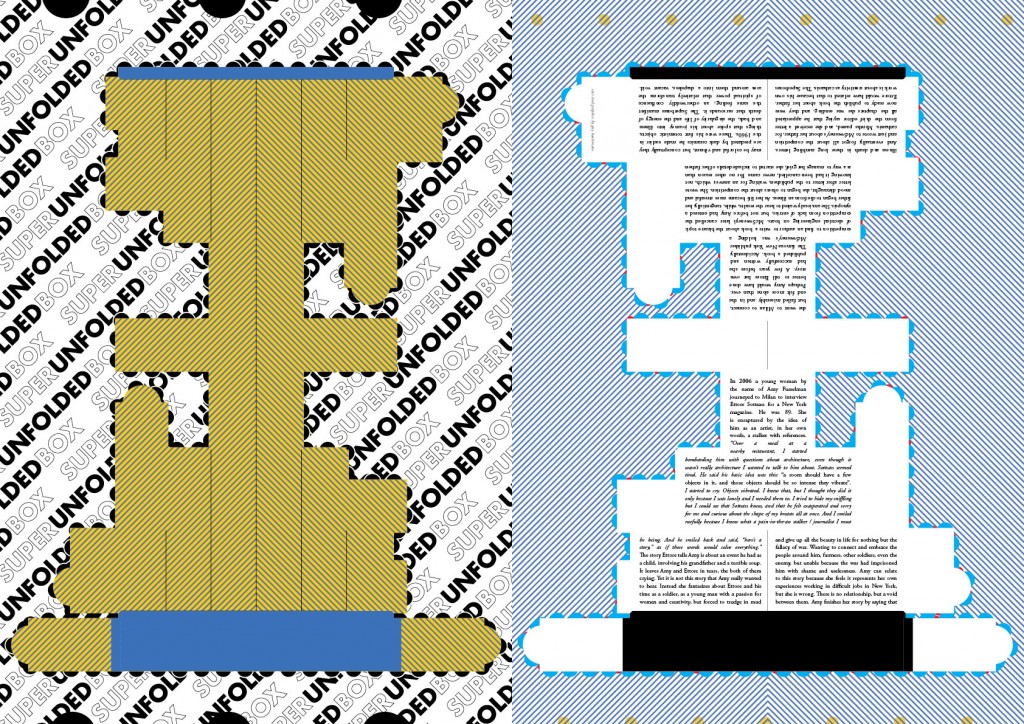superunfoldedbox
In January 2010, I contributed to the exhibition We Were Exuberant and Still Had Hope. Ettore Sottsass: works from Stockholm, 1969 at the Marres Centre for Contemporary Culture, curated by Lisette Smits and Guus Beumer. This exhibition featured some extraordinary work of Ettore Sottsass from the 1960’s, including three of his rare Superboxes and a large ceramic alter. These works were previously exhibited in Sweden in 1969 and have not been publicly seen since then. Smits and Beumer reconstructed the previous exhibition with the addition of some original elements, such as purple fluorescent lights and orange-yellow walls which framed the bold Sottsass work dramatically, especially at night when I was working at the Centre. Upstairs, I presented an interpretation of Sottsass’ Superboxes, entitled superunfoldedbox. This installation was produced from custom die cut and printed cardboard sheets which popped out and folded up into do-it-yourself style model Superboxes. These were assembled together on the floor and matched with blown up wall prints of each design. The 3 designs were based on 3 different presentations of Superbox produced by Sottsass; a 1:1 prototype, a scale model, and a presentation sketch, and were available as handouts for visitors to take home, or add to the growing collection on the floor.
above, Ettore Sottsass Superboxes c. 1965–8, 1:1 prototype, illustration, scale model.
above, Ettore Sottsass Superboxes c. 1965–8, 1:1 prototype, illustration, scale model.
above, Installation views.
My purpose was stimulate thinking about the Superboxes. They are unique and progressive 20th century objects that created a new merger of art and design, and their conceptual message about consumerism has not blunted in the 40 years since they were conceived. Curator Lisette Smits titled my contribution to the exhibition as Guy Keulemans, Objects for Atheists (Superunfoldedbox), seeing a direct relationship to my research document of that name, and in some ways this connection is very important and is something I explain in my earlier post about this project. The process of taking a flat surface and building up a three dimensional form, in mind, as a mental construct, that must take place before any physical construction of the cardboard model (although sometimes only a fraction of a second beforehand) is a metaphor for the construction of epistemological thought. The opposite is also true. The Superboxes are reverse engineered – by extrapolating how Sottsass’ designs can be presented as a two-dimensional schematics I propose, “to understand something you must open it up and take it apart.” Additionally, cardboard materials and multiplicity of the models is a references to democratization. The original Superboxes are so rare and valued (and in fact the exhibits downstaired were insured for 1 million euros), that it is fun to see their form and colour in the most disposable and inexpensive medium conceivable!
Yet, simply, I wanted to educate about the Superboxes. So, much like going to the Natural History Museum and coming home with a model dinosaur kit, visitors can take home a model Superbox and keep it on their desk for contemplation. The boxes can be folded up in two ways. One way to produce a “correct” colored Superbox, or in reverse, revealing a black and white text. The text for each box is one of three micro-eassys I wrote about Sottsass and his work, which I include below under the subtitles for each box, BLUE, RED and and YELLOW.
BLUE
“In India I found very strongly a sort of dimension of sacrality.
Every object could become something so related to your life that it becomes your vision of the sacred”.
Ettore Sottsass spent three months in India in the early 1960s. Later, back in Italy, he nearly died from a rare illness. Roberto Olivetti sent him to the United States for an experimental treatment that saved his life. The experience motivated a search for deeper meanings in his life and work. By the time Sottsass had designed his famous Valentine typewriter, he said,
“I didn’t want to do any more consumerist products, because it was clear that the consumerist attitude was quite dangerous….”
We live in a world defined by consumerism. An increasingly evolved capitalist society has produced a society that finds personal meaning in possessions. An immaterial, transcendent, sense of place or purpose in our lives is missing because the structure that normally deals with this, religion, has not adapted sufficiently to changing beliefs formed by scientific discovery. For many people, science clearly demonstrates intellectual superiority by its production of material technologies. The things with which we surround our modern selves: movies, computers, giant trucks, skyscrapers and everything et al., are things which amaze us. This amazement reinforces our material senses at the cost of our spiritual senses.
Ettore Sottsass recognized a problem over 40 years ago, after traveling to India and the United States. As a designer he had an eye for materialist concerns and in India, he saw that the average Indian had few objects in his or her life. Combined with a denial of materialist values inherent to Hinduism meant that objects were valued for their utility or spiritual purpose, but were not necessarily the focus of irrational desire or obsession. In the States, he saw the opposite. Economic wealth and industrial production gave material wealth to almost everyone. Objects were appreciated for the status and utility they conferred, but discarded as soon as the next best thing came along. This was the reason Sottsass was so impressed by some of the new American artists; the Beat writers, but also the Abstract Expressionists. He saw their art as a reaction to the obsession with materialism. These artists were returning to transcendent values by reducing form to simply “surface and material”, as Clement Greenberg wrote. What is valued if very little is even there? Sottsass returned to Italy with a spring in his stride. He had understood that his designed objects could be critical, minimal and precise. Yet, there was also something he could apply from what he saw in India: a sense of the spectacular, the overwhelming and the sacred.
RED
“…we draw our product language stimuli not so much from institutionalized culture, not from technology, not from some sort of institutionalized certainty, but from spheres where everything starts afresh again, is uncertain, contradictory, without firm outlines.”
For an object to reflect an intangible worldview and speak to the heart intuitively, it must contain some aspect of irrationality, to elevate it above conscious understanding and into the realm of the emotional. This contrast, one could say even a duel, between rational and irrational concerns is an important attribute in the work of Ettore Sottsass, and responsible for much of its emotional impact.
Sottsass had an urge to travel around the world intensively, running from place to place with fervour and a mad desire to photograph everything. At one point he took 1873 photographs in 12 days in South America. He is described as travelling to consume life, yet he is also disgusted and appalled at the consumption of others. His travels to the United States in 1956 revealed American consumerism to him and led him to develop objects that were “tools to slow down the consumption of existence” as if he was designing to self-medicate his own manic personality. He sought to surmount self-esteem issues with constant and passionate ambition. Sottsass wanted to get rid of rationalism, which he said, “did not cover by any means the necessities of existence”. One of his reactions to rationalism was to break it apart and reform it. His wife and biographer Barbara Radice says that with the very rational Bauhaus, he took its elements and performed a “transplant operation”. Sometime he re-arranged the ratios, distances and weights that he saw in the Bauhaus style into an “irony of disproportion”, seen in much of his ceramics and furniture. At other times this transplantation produced a playful hyper-rationalism, such as in his groundbreaking work for Olivetti. The Olivetti computers and typewriters are streamlined, strict yet soft machines; as if he had thrown all the elements of modernism into the air to see the kind of chaos in which they would land, but they had reformed by chance into a perfectly formulated solution.
“When I began designing machines I also began to think that these objects…. …can touch the nerves, the blood, the muscles, the eyes and the moods of people. Since then I have never designed a product in the same way as I would design a sculpture, and I have been utterly obsessed with the idea that… …I was setting off a chain reaction of which I understood very little.“
YELLOW
In 2006 a young woman by the name of Amy Fusselman journeyed to Milan to interview Ettore Sottsass for a New York magazine. He was 89. She is enraptured by the idea of him as an artist, in her own words, a stalker with references.
“Over a meal at a nearby restaurant, I started bombarding him with questions about architecture, even though it wasn’t really architecture I wanted to talk to him about. Sottsass seemed tired. He said his basic idea was this: “a room should have a few objects in it, and those objects should be so intense they vibrate”.
I started to cry. Objects vibrated. I knew that, but I thought they did it only because I was lonely and I needed them to. I tried to hide my sniffling but I could see that Sottsass knew, and that he felt exasperated and sorry for me and curious about the shape of my breasts all at once. And I smiled ruefully because I knew what a pain-in-the-ass stalker / journalist I must be being. And he smiled back and said, “here’s a story,” as if those words would solve everything.”
The story Ettore tells Amy is about an event he had as a child, involving his grandfather and a terrible soup. It leaves Amy and Ettore in tears, the both of them crying. Yet it is not this story that Amy really wanted to hear. Instead she fantasizes about Ettore and his time as a soldier, as a young man with a passion for women and creativity, but forced to trudge in mud and give up all the beauty in life for nothing but the fallacy of war. Wanting to connect and embrace the people around him, farmers, other soldiers, even the enemy, but unable because the war had imprisoned him with shame and uselessness. Amy can relate to this story because she feels it represents her own experiences working in difficult jobs in New York, but she is wrong. There is no relationship, but a void between them. Amy finishes her story by saying that she went to Milan to connect, but failed miserably and in the end felt more alone than ever.
Perhaps Amy would have done better to tell Ettore her own story. A few years before she had successfully written and published a book. Accidentally. The famous New York publisher McSweeney’s was holding a competition to find an author to write a book about the bizarre topic of electrical engineering on boats. McSweeney’s later canceled the competition from lack of entries, but not before Amy had entered a synopsis. She anxiously waited to hear the results, while, tangentially, her father began to die from an illness. As her life became more stressful and mood distraught, she began to obsess about the competition. She wrote letter after letter to the publishers, waiting for an answer, which, not knowing it had been canceled, never came. For no other reason than as a way to manage her grief, she started to include details of her fathers illness and death in these long rambling letters. And eventually, forgot all about the competition and just wrote to McSweeney’s about her father, for catharsis. Months passed, and she received a letter from the chief editor saying that he appreciated all the chapters she was sending, and they were now ready to publish the book about her father.
Ettore would have related to that because his own work is about creativity as catharsis. The Superboxes may be colorful and vibrant, but conceptually they are predated by dark ceramics he made earlier in the 1960s. These were his first totemistic objects, things that spoke about his journey into illness and back, the singularity of life and the energy of death that surrounds it. The Superboxes manifest the same feeling, an otherworldly confluence of spiritual power that relatively transforms the area around them into a shapeless, vacant void.

